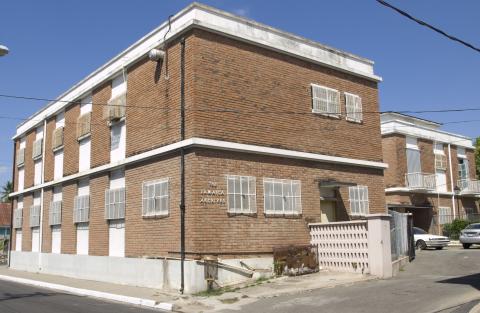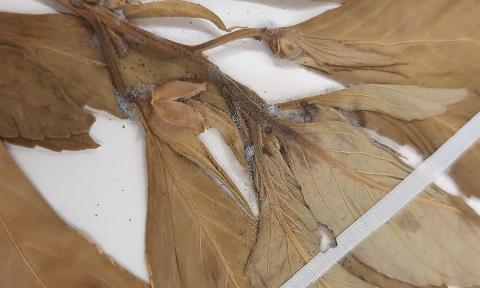
Aims and objectives
This pilot project has been generated by a multi-disciplinary, longitudinal study of the enslaved population of Mountravers, a Bristol-owned sugar plantation on the Eastern Caribbean island of Nevis in the Federation of St Kitts and Nevis. Annual field-trips since 1998 have focused on both the archaeology and the documentary material relating to the enslaved populations of Mountravers and neighbouring estates. These estates are now themselves under pressure from the increased pace of unsympathetic development.
The research has found that the main local collection of primary source material relating to the slave populations of approximately one hundred estates on Nevis consists of legal records in the island's courthouse. At least 45 volumes of Common Records are known to cover the eighteenth and nineteenth centuries together with a small number of other legal records. There may also be a large number of volumes recording cases in the Court of the King's/Queens Bench and Court of Common Pleas. There is certainly an unknown quantity of loose material stored haphazardly both on shelves and on the floor in the courthouse vault.
Primary source material recording the history of Nevis can be found in several private collections in Britain including the Pinney Papers at Bristol University. Political and economic material can also be found in the (British) National Archives but the Nevis Courthouse Records are the only other known source. Nevis played a significant role in Atlantic history, being one of the earliest Caribbean islands settled by the British (1628). Thousands of enslaved West Africans were brought there, particularly in the late seventeenth century when Nevis was the location for the Royal African Company's only 'factory' in the Leeward Islands. From Nevis there has been a continual process of emigration to, and settlement in, other islands in the Caribbean and to North America. For these reasons the Nevis collection has an international significance.
However, the collection is equally important to Nevisians. In the legal records can be found the wills of free black Nevisians, former slaves and planters, together with manumissions recording the freedom of individuals. There are mortgages of property and slaves listing whole enslaved populations on particular estates, together with detailed histories of landownership. The documents include some estate plans. These are rare for Nevis and provide clues for the location of slave villages, a process which has only just begun on Nevis. Also to be found are plans of individual house plots in newly formed post-emancipation villages.
Careful analysis of these records will allow historians and archaeologists to compare social development before and after emancipation, investigate patterns of family life, examine the growth of an independent, small-scale economy, locate slave and post-emancipation villages and identify changing patterns of land ownership and use. Significant for the future is the potential for Nevisians to try and regain some of their family history. Because parish records are very patchy most Nevisians can only do this for two or three generations, mostly through oral history. Inevitably, as time passes, the earlier history is being lost.
In common with records in other small Caribbean islands, the Courthouse Records are seriously at risk. The building is threatened by hurricanes although the vault is more likely to be flooded being close to the shore. Inspection shows that the records are deteriorating from the acidic content of the original ink, the variable quality of the paper, 'weevil' damage, lack of air-conditioning and the consequent relative humidity. However, the principal source of damage is the method of storage. The volumes have been kept in no particular order nor are they adequately labelled and spines and covers are regularly damaged in the consequent search for a particular volume. Lack of storage has meant that nineteenth, twentieth and potentially eighteenth-century records are stored on the floor of the vault and access to shelved records has required climbing on piles of these documents. In addition, because of the crowded nature of the vault it is not clear if anyone knows the extent of the archive.
The aim of the pilot project is to survey this courthouse archive, assess the extent of the damage being done to it, identify key sets of documents and investigate the potential for copying and relocating them, or simply copying them. The project aims to assess the political will to allow copying and/or relocation and the local capacity to carry out the work. In addition the project aims to identify whether or not there are other potential sources of documentary evidence on the island within the various government departments and in private hands. The information gathered in the pilot project will be used to develop plans and aid further grant proposals. Hopefully the project may lead to a model for the protection of endangered records on other small Caribbean islands.
Outcomes
The condition of the records held in the Courthouse Vault and also, to some extent, in the Courthouse office, has been surveyed and assessed. Important sets of documents in the Courthouse have been identified, in particular the Common Deed Record Books, Books of Wills and Land Title Register Books with their attached estate plans. Their profile has been raised markedly with key officials both in the Court and in the wider community.
Key personnel and organisations have been identified who can help in the process of copying, relocating and safeguarding the material and would be interested in doing so. Parameters have been identified, including political constraints, which will affect the willingness of local people and organisations to assist in the process of copying and relocating the documents.
Apart from the Supreme Court Registry on Nevis, other sources of records concerning Nevis have been identified, both on Nevis and on St Kitts, in the form of Government records at the Registrar General's Office (vault records surveyed), the National Archives on St Kitts (although these are not endangered) and in the records of both the Anglican and Methodist Churches. There are also useful records in a privately run museum on St Kitts. It has become clear that there are almost no documentary records concerning the Colonial period in private hands on Nevis.
Recommendations have been made as to practical steps which could be taken on the island, irrespective of any further application for a grant to copy and relocate the endangered records.
In summary, endangered records relating to Nevis are currently known to be held at the following locations:
Supreme Court Registry (vault and office), Charlestown, Nevis
Registrar General's Office (vault), Charlestown, Nevis
Nevis Treasury (vault), Charlestown, Nevis
Methodist Church Office, Charlestown, Nevis
Anglican Parish Offices of St George Gingerland and St John Figtree, Nevis
Edgar Challenger International House Museum, Basseterre, St Kitts
No material has been copied to date or relocated as this has not yet been agreed with the Nevis Island Administration.





